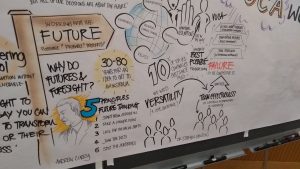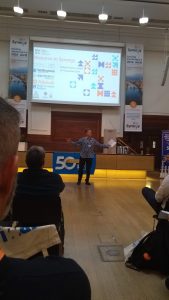
Andrew Curry writes: I was invited to talk at the 50th anniversary event of the UK chapter of the Institute of Project Managers earlier this month. My subject: Working With The Future.
It was an engaging event, held in the Quaker Friends’ House in Bloomsbury, in London. The tone for the day was set by Paul Lyalls, the facilitator, who’s also a working poet.
I did three things in my short slot. First, introduce the audience to the nature of futures thinking, and why it is different from other approaches to strategy, innovation or risk management. Second, to give a rapid overview of the high level trends shaping the next twenty years. And third, to give them a quick taste of applying these—in this case to the future of project management. The talk was summarised by the visual facilitators Inky Thinking–as seen in the image above).
Slowing down
To look at the trends, I used the ‘futures diamond’ that I have written about elsewhere: Demographics; Economics; Technology; Values. Sitting in the middle of these is Resources/Climate Change. This is generally a depressing perspective. Despite the many claims that change is speeding up, a lot of this is slowing down.
The rate of growth in the world population is now declining, which means that globally we have a shrinking workforce. In the global North, rates of growth have been slowing since the mid-60s, but now have reached the point where they have political and social impact. (Growth rates are also falling in Asian countries). Technology markets are saturated, and returns on investment are falling, although we’re likely to see continuing social innovation.
Values are more interesting. We’re about halfway through a long shift, suggest Inglehart and Norris, from ‘modern’ to ‘post-materialist’ values. Modern values are about authority, conformity and hierarchy; post-materialist values about autonomy, creativity and self-expression.
And resources sit in the middle, responding to the pressures from the other four, heading towards crisis.
Systems require energy to change. The energy here is in two places. First, the values of the teenaged generation, and the Skolstrejk movement, second the vast pool of cheap money looking for a better home. Put these two together, and the home it might be able to find is the $93 trillion of investment needed in the next 15 years to avert the climate crisis. We just need some innovation to join them together.

